Brewing up an event steeped in culture
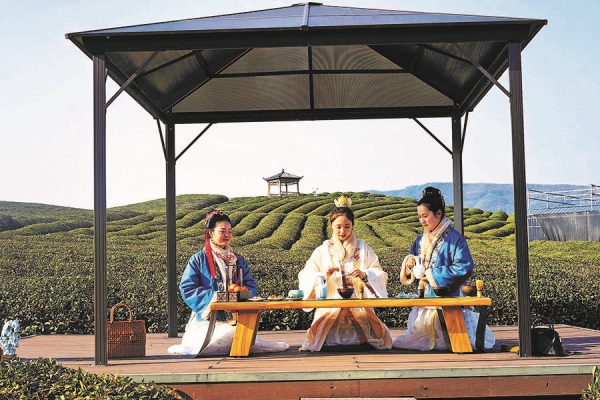
Innkeeper and tea sommelier Zhang Hongyan (right) prepares tea with her team at a tea plantation in Hangzhou, Zhejiang province. [Photo provided to China Daily]
Tea ceremony in Jingshan village, Zhejiang province's Hangzhou city, celebrates the drink and its fascinating history, Cheng Yuezhu reports.
Nestled in the foothills of Jingshan village, Zhejiang province's Hangzhou city, quietly lies an inn named Wufeng Shanfang. With a decor that exudes Chinese antique elegance, the inn sets the scene for an immersive experience, inviting visitors to don traditional attire and relish a cup of tea.
Occasionally tea-tasting ceremonies are hosted inside the inn, where tea sommeliers reenact how the ancient Chinese prepared and tasted the drink, highlighting elegant minutiae, taking the visitors on a journey into Jingshan village's age-old tea culture.
Or, more casually, visitors can simply sit down with the innkeeper Zhang Hongyan, sipping tea while listening to Zhang introducing the story of tea and telling her own life stories.
"I used to have a regular nine-to-five job, but eventually quit because of health issues. At the time, my parents were considering entering the hotel business, so I came back to help them. I was very introverted and everybody thought I wouldn't manage," she recalls.
As Jingshan village is known for Jingshan tea, a type of green brew with a time-honored history, the leaves of which grow in the mountains, like many locals of the village, Zhang's parents worked in the sector and established their own tea-processing factory.
With an inherent passion for tea, in 2016, 29-year-old Zhang started learning about it while working on opening the inn. She undertook training and became a certified tea sommelier and assessor.
"When I was younger, I often felt stressed or agitated. And having studied tea, I feel that my personality has gradually changed. For example, introducing the tea culture to the guests injects me with happiness," Zhang says.
"Now I think I've discovered the virtue of broad-mindedness and learned to influence other people with love, and treat all people genuinely and candidly."
She is among the sommeliers who perform tea whisking, a preparation technique that prevailed in the Song Dynasty (960-1279), at the folk edition of the time-honored Jingshan Tea Ceremony.
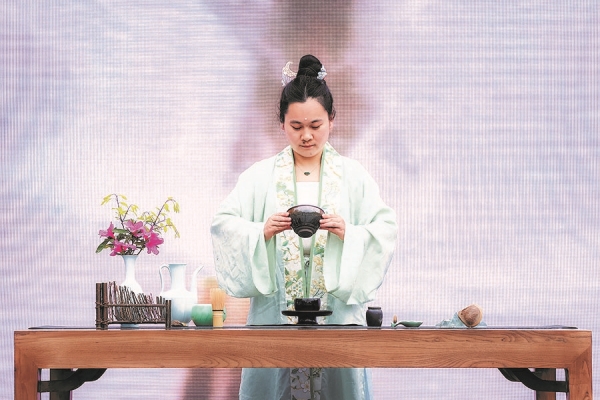
Zhang performs traditional tea preparation techniques at a competition in Yuhang district, Hangzhou. [Photo provided to China Daily]
The ceremony was listed as a national-level intangible culture heritage in 2011 and, in 2022, inscribed on UNESCO's Representative List of the Intangible Cultural Heritage of Humanity as a part of the traditional tea-processing techniques and associated social practices in China.
The ceremony originated at the Jingshan Temple, located on top of the Jingshan Mountain. Built in the Tang Dynasty (618-907), the temple has a history of more than 1,200 years.
Throughout that history, the temple has been closely connected with tea, as the earliest textual records register that the temple's founder offered tea as a sacrifice to Buddha.
Sitting in silence and relishing a cup of tea became a medium through which the monks delved into their spiritual world and achieved a state of deep mindfulness.
During the Song Dynasty, the ceremony evolved into its full form, with more than 10 formal procedures, including welcoming the guests, burning incense and paying tribute, as well as making and drinking the tea.
By hosting these ceremonies, guests, the majority of whom were literati and bureaucrats, had the chance to sit down and seek wisdom alongside the monks.
According to Yanping, a monk at the temple and an inheritor of the art form, the Jingshan Tea Ceremony is believed to be the origin of the Japanese tea ceremony known as Sado.
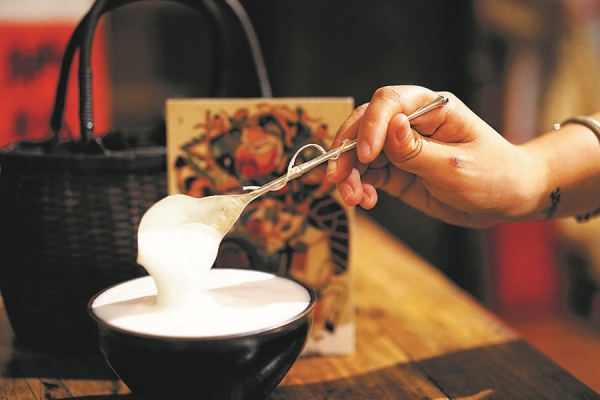
Tea whisking involves stirring tea powder and hot water until a thick layer of white froth emerges on the surface of the tea. [Photo provided to China Daily]
Back in the Tang Dynasty, a Japanese monk who studied at Jingshan Temple took tea drinking back to Japan, and in the Song Dynasty, two other influential monks, Enni Ben'en and Nanpo Shomyo, introduced the temple's tea traditions to Japan.
Despite Jingshan Temple's venerable status in the history of tea, Zhang says that around 10 years ago, even most of the locals didn't know about the ceremony, nor the rich legacy of Jingshan tea, which they grow and drink on a daily basis.
"Jingshan village is the core production area of Jingshan tea, and it naturally became our duty to tell the story of Jingshan tea in a compelling way. We came to realize that, to support the development of Jingshan tea, we must delve deeply into both its past and present," says Yu Ronghua, Party secretary of Jingshan village.
From 2012, Yu led a team in visiting folk tea masters and monks at the temple, as well as researchers and scholars of tea, in the hope of restoring a folk edition of the ceremony, so that more people would have the chance to learn about and participate in this tradition.
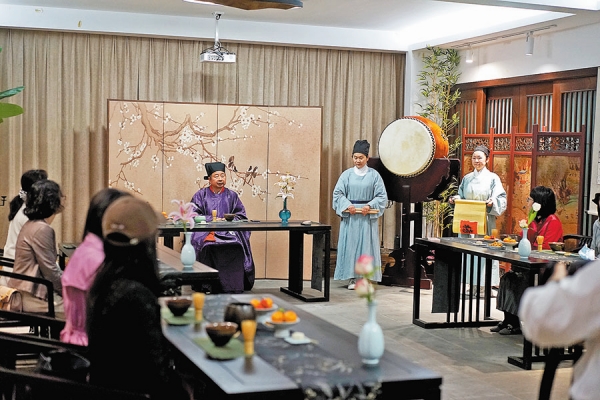
Zhang's inn is also a venue for the folk edition of the Jingshan Tea Ceremony. [Photo provided to China Daily]
It took them around three years to come up with the first edition of the folk version, aiming to reenact the tea-drinking practices of the Song Dynasty, with tea sets, tools, tables and garments, all re-created according to historical records.
"To draw more people into taking part, we need to ensure the event's visual appeal, immersive experience and interaction, so we incorporated lifestyle elements into the folk version," Yu says.
The folk ceremony resembles the traditional salons in which scholars and the literati participated. Apart from drinking tea and tasting various tea-based refreshments, guests are encouraged to showcase their own skills, from practicing calligraphy to playing the guqin (seven-stringed Chinese zither).
Meanwhile, as the event is rooted in the ceremony from Jingshan Temple, the folk edition also invites Buddhist monks to give lectures about the history of the ceremony and the Zen properties of drinking tea.
These activities now take place frequently at various venues in the village, from the village auditorium to inns and teahouses, as Yu aims for tourists to be able to experience the village's tea culture whenever possible.
Zhang's inn is one of the venues for these folk ceremonies and tea-tasting sessions. Zhang and her team are also often invited to perform at other events, or to help popularize tea culture at schools, companies and fairs.
"One of our team members used to be the local seafood stall owner, and another ran a hair salon. I invited them to join me because I found that they are also interested in traditional culture such as tea and hanfu (traditional Chinese attire)," Zhang says.
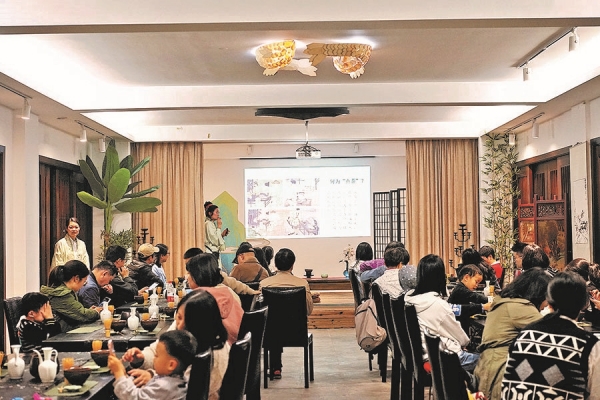
In Zhang's inn, a sommelier gives a lecture about tea whisking, a technique that prevailed during the Song Dynasty (960-1279). [Photo provided to China Daily]
Since dedicating herself to promoting tea culture, Zhang also feels a renewed sense of achievement.
"The most prominent evidence is that, during my school days, I never received any awards, but having opened the inn with Jingshan tea at its heart, I have been granted multiple awards and honors, and the inn itself is prized as a municipal-level intangible cultural heritage featured inn," she adds.
"I truly feel that we're quite an excellent team, and this journey into tea has instilled a deep sense of confidence in me. I also acquired a deeper understanding of the richness of Chinese culture and the true meaning of cultural confidence."


